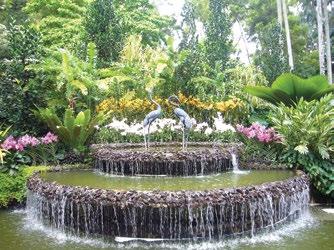
4 minute read
Singapore: A City in a Garden

By Jane Thurgood Sagal
Singapore is a young country – 200 years old. Orchard Street is a main thoroughfare with high end stores sharing the street alongside outdoor art and musicians. A highlight of my stay is a visit to the Singapore Botanic Gardens, including the beautiful National Orchid Garden where a VIP section profiles orchids developed and named after VIPs such as Jean Chretien and Princess Diana.
Singapore is famous for orchids; the National Orchid Garden is situated on the highest hill in the Botanic Gardens. Orchids have been part of the collections since the gardens’ beginning in 1859. Early directors commissioned extensive orchid collecting expeditions. The Botanic Gardens are one of the few pockets of original jungle left in Singapore, home to 300 plant species and plenty of birds including oriental pied hornbills, spotted wood owls, crimson sunbirds, and stork-billed kingfishers.
A similarly fascinating visit is to the Kranji area, full of nurseries and mangroves, the only food-producing area in Singapore. I savour a delicious lunch at Bollywood
Veggies 10-acre organic farming collective that includes a surfeit of garden spaces for papaya trees, lily pad ponds, a kitchen garden (to supply the restaurant), and other inspired group plantings. Ivy, the gentle warrior and owner of the farm, planted over 30 different varieties of bananas in her banana garden. One banana varietal grows only to the length of my baby finger! As required by government, Ivy had to prove that her farming collective would be viable for at least 30 years, prior to engaging in the project.
‘New things from 17
From Bollywood Veggies, I head to Thow Kwang Dragon Kiln to learn how pottery used to be made in this quiet corner of Singapore. With the appearance of a dragon’s belly, this rarely-fired kiln stands as a reminder of a bygone era. You can duck inside the kiln from several side entrances and walk crouched over through the large, curved structure.
I also ventured to the stunning Gardens by the Bay –a park spanning 101 hectares of reclaimed land adjacent to the Marina Reservoir. The extraordinary project brings to life the vision of the government to make the island city-state a ‘City in a Garden’. Two enormous conserva-

“Also, being closer to spring, we will be having several on-the-land classes/workshops where people will be able to get their hands dirty and harvest some first foods. These events usually carry through to our seasonal feasts and campouts that we do during the year.”
Jenny added, “We get excited about all the work we do... when we can teach young people and be reminded to see the world through the same wonderment of a childway they communicate to all living things (ʔa·kxamis qapi qapsin’).”
Jenny and Darcy are not only changing with the seasons but walking through them with their new book they co-wrote, Walking Through the Seasons-Ethnobotany of the Ktunaxa and Interior Salish. Darcy said the book had been in the making for years and the formatting to publish it began in August 2022.
It’s knowledge within, a combination of both the experience and learning during Jenny and Darcy’s lifetime.
“I love plants and all they gift to us,” said Jenny. “I have family that have left their knowledge and love for plants through their recollection in written form and to share our stories and knowledge feels like the best way to honour their memory.”
Darcy adds, “I’d echo what Jenny said, in that we honour ourselves and future generations. The book has valuable plant knowledge coupled with our personal stories and experience of walking through the seasons. We are planning on having the book available (including having) physical copies to hand out at our different events.”
The workshops and courses offered though Keepers of the Seasons not only aim to inspire and influence positive change and healing but delve into personal and professional growth.
“Our goal is to continue sharing our knowledge and to have more teaching experiences and events,” said Darcy. Jenny added, “We hope that people can grow their personal experiences with all living things (ʔa·kxamis qapi qapsin’). We hope that we can inspire more people to learn the language of the plants, nurture young and new learners, and have more events for people to attend, and to spend more time in B.C. - specifically up there in the valley.” tories and a grove of ‘super trees’ dominate the site. The cooled conservatories are an energy efficient showcase of sustainable building technologies that house exotic plants from South Africa, California, southern Spain, Italy, and southwestern Australia.
‘Super tree’ is the name given to the towering, 16-storey structures that act as frames for clinging and flowering plants, as well as providing supports for solar panels. The super trees are lit at night in exhilarating displays. Each super tree structure encloses several levels with ramps and upper walkways to entice full exploration of the lush foliage inside.
Upon return from travels, I am often asked about highlights of my trip. For Singapore, my response is the Botanic Gardens, the Dragon Kiln, and the super trees –etched in my mind forever.

Columbia Valley Food Bank hired executive director
By Joanne McQuarrie editor@columbiavalleypioneer.com
“It’s great!” said Katrina Chapman about her new position as executive director at the Columbia Valley Food Bank (CVFB).
Chapman started on January 30; she’s the first-ever executive director the CVFB has had. “It’s a really nice environment, well-organized,” she told the Pioneer. “People are good to work with, motivated. They’re passionate about the work they do, and committed to the work they do.”
Those qualities mirror Chapman’s own. “I actually have been working toward a position such as this since 2012,” she said. “Food systems development; it’s a way to address many challenges we have in society, with food as a focus.”
Chapman noted in a text that “with a diverse background in community development and organizational change, I look forward to supporting the food bank to align its optimal potential with the dynamic assets of the Columbia Valley”.
“Improving the well being of communities in the Columbia Valley by providing healthy food options to those in need is the cornerstone of our work. Work that is brought to fruition by an established operational mandate, to continually provide accessible solutions to diverse challenges we serve.”
Chapman told the Pioneer, “There’ll be community outreach and engagement. There’ll be volunteer coordination and engagement and recruitment. And internal operations will be enhanced; for example, financially-related, coordinating volunteers, organizational coordination.” The CVFB is connected with other entities in the community and Chapman works with the CVFB board.
“It is my commitment to develop and enhance the legacy of goodwill that the CVFB was built upon,” Chapman continued in a text message. “As the organization continues to grow, evolve and improve its internal and external capacities, I look forward to future collaborations that will enhance our offerings and continue to improve lives.”







